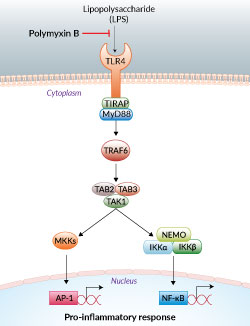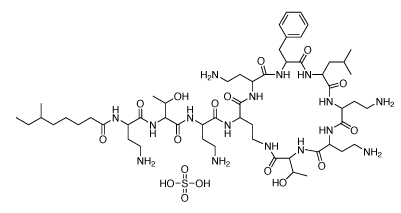Polymyxin B
| Product | Unit size | Cat. code | Docs. | Qty. | Price | |
|---|---|---|---|---|---|---|
|
Polymyxin B LPS-induced TLR4 activation inhibitor - InvitroFit™ |
Show product |
100 mg |
tlrl-pmb
|
|
LPS-induced TLR4 activation inhibitor

TLR4 inhibition by Polymyxin B
Polymyxin B is a cyclic cationic polypeptide antibiotic produced by the soil bacterium Paenibacillus polymixa. It inhibits LPS-induced Toll-like receptor 4 (TLR4) activation [1]. TLR4 is a pattern recognition receptor that primarily recognizes and is activated by a core component of the outer membrane of Gram-negative bacteria, lipopolysaccharide (LPS).
Mode of action:
Polymyxin B blocks the biological effects of Gram-negative lipopolysaccharide (LPS) through binding to lipid A, the toxic component of LPS, which is negatively charged [1-3].
The neutralizing effect of polymyxin B on LPS is dose-related and specific for LPS [4]. Polymyxin B is widely used to eliminate the effects of endotoxin contamination, both in vitro and in vivo.
Key features:
- LPS-induced TLR4 activation inhibitor
- InvitroFit™ grade: each lot is functionally tested
References:
1. Goode A. et al., 2021. Interactions of polymyxin B with lipopolysaccharide-containing membranes.Faraday Discuss. 232(0):317-329.
2. Velkov T. et al., 2013. Pharmacology of polymyxins: new insights into an ‘old’ class of antibiotics. Future Microbiol. 8(6):711-24.
3. Alipour M. et al., 2008. Antimicrobial effectiveness of liposomal polymyxin B against resistant Gram-negative bacterial strains. Int J Pharm. 355(1-2):293-8.
4. Trimble M.J. et al., 2016. Polymyxin: Alternative Mechanisms of Action and Resistance. Cold Spring Harb Perspect Med. 6(10):a025288.
Specifications
Working concentration: 10- 100 μg/ml
Solubility: 50 mg/ml in water
CAS number: 1405-20-5
Molecular weight: 1301.56 g/mol
Formula: C56H100N16017S
Quality control:
- The inhibitory activity has been validated using cellular assays.
- The absence of bacterial contamination (e.g. lipoproteins and endotoxins) is confirmed using HEK-Blue™ TLR2 and HEK-Blue™ TLR4 cells.
Contents
- 100 mg Polymyxin B (Sulfate)
![]() Polymyxin B is shipped at room temperature.
Polymyxin B is shipped at room temperature.
![]() Upon receipt, store at 4°C.
Upon receipt, store at 4°C.
![]() Upon resuspension, filter sterilize and store at 4°C. The resuspended product is stable for 1 month at 4°C.
Upon resuspension, filter sterilize and store at 4°C. The resuspended product is stable for 1 month at 4°C.
Details
Toll-like receptor 4
Toll-like receptor 4 (TLR4) was the first TLR identified and is an important pattern recognition receptor (PRR) in innate immunity and inflammation. TLR4 is found both on the cell surface and in endosomes of innate immune cells including monocytes and macrophages, as well as on intestinal epithelium and endothelial cells [1]. TLR4 primarily recognizes and is activated by lipopolysaccharide (LPS) and its toxic moiety Lipid A, a core component of Gram-negative bacteria [2]. TLR4 does not directly interact with LPS and requires essential co-receptors, namely lipid-binding protein (LBP), MD-2, and CD14, to extract and deliver monomeric LPS to TLR4 [3]. There are two distinct signaling cascades triggered by the dimerization of TLR4; the MyD88-dependent (at the cell surface) and TRIF-dependent (in endosomes) pathways. At the cell surface, activation of TLR4 initiates the MyD88-dependent pathway, ultimately leading to the ‘early’ activation of NF-κB and the production of a pro-inflammatory response [3]. Subsequently, the TLR4 complex can be endocytosed into endosomes and result in the ‘late’ activation of NF-κB as well as the stimulation of IRF3 (interferon regulatory factor), which modulates the expression of type I IFNs [4]. TLR4 signaling is crucial in both acute and chronic inflammatory disorders and is thus an attractive target for novel treatments for conditions such as sepsis and cancer [1].
References:
1. Ou, T. et al. 2018. The Pathologic Role of Toll-Like Receptor 4 in Prostate Cancer. Front Immunol 9, 1188.
2. Cochet, F. et al. 2017. The Role of Carbohydrates in the Lipopolysaccharide (LPS)/Toll-Like Receptor 4 (TLR4) Signalling. Int J Mol Sci 18
3. Kuzmich, N.N. et al. 2017. TLR4 Signaling Pathway Modulators as Potential Therapeutics in Inflammation and Sepsis. Vaccines (Basel) 5.
4. Marongiu, L. et al. 2019. Below the surface: The inner lives of TLR4 and TLR9. J Leukoc Biol 106, 147-160.
Chemical structure of Polymyxin B







